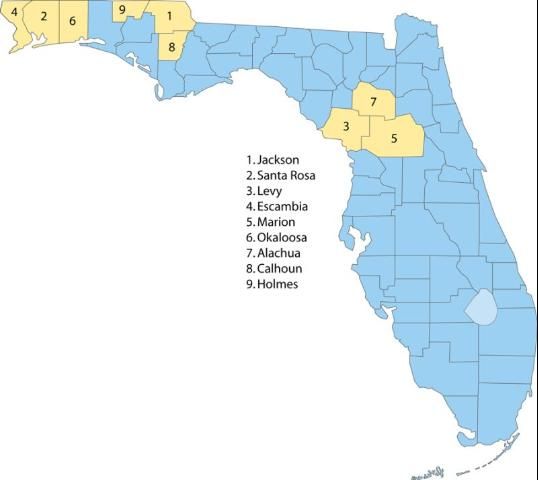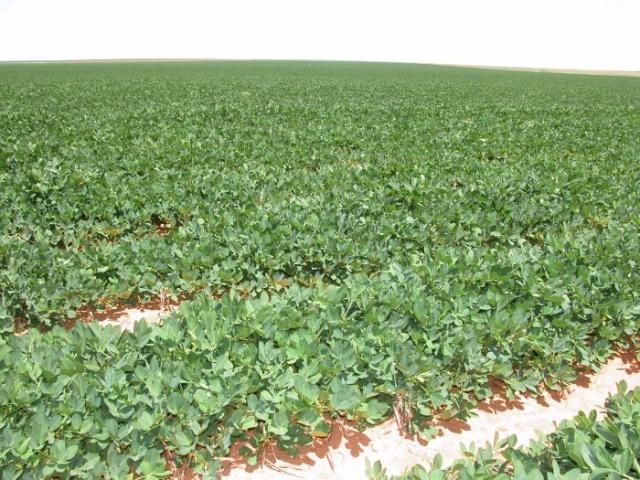Production of Biofuel Crops in Florida: Peanut1
Introduction

Credit: Hope Crawford, UF/IFAS
Peanut (Arachis hypogaea) is an annual legume that is commonly grown in the southeastern, midsouth United States and Texas. This crop is well adapted to sandy Coastal Plain soils and does well on relatively infertile, droughty soils. It is one of the few crops that do well when grown on deep sands and responds to rotation as much as or more than most agronomic crops. The majority of peanut acreage in Florida is in north and central Florida but it can be grown throughout Florida and the Southeast. Florida grows about 170,000 acres of peanut annually. Peanuts are generally used in rotation with other crops such as cotton and corn. Florida has the longest ongoing peanut breeding program in the US and has released many peanut varieties grown across the peanut belt. Florunner, developed in Florida, was the dominant runner peanut variety grown in the US for more than 20 years. Florida germplasm is in the parentage of the most commonly grown varieties today even though a Georgia developed variety currently dominates the market. Peanuts will continue to be grown in the Deep South due to the long growing season and adaptability to sandy, droughty, infertile soils.
Current Potential for Use as Biofuel
Peanut is widely adaptable for the southeastern United States, has high oil content (45–52%) compared to many of the other oilseed crops, and could produce more biodiesel (more than 150 gallons of fuel per acre) than most of the other oilseed crops currently grown commercially in the Southeast. Since peanuts are generally planted in rotation with grass crops or cotton, they need no direct fertilization aside from liming and boron under most conditions. Purposeful breeding and selection of varieties suited for biofuel production could greatly enhance the potential for peanut in the biodiesel market. Because peanut grade and quality are not important for the biofuel market, there already may be several potential breeding lines suited to the biofuel market, that have been discarded due to non-uniform size or other characteristics that make them unfavorable for the edible market.
Biology of Peanut
Peanut is a warm-season annual legume crop that requires 125–150 days from planting to maturity. Peanuts begin pegging about 28 days after planting and continue pegging and flowering for another 5–6 weeks. After this period, pods begin to fill. During the pod-fill time peanuts have a high water requirement. Peanuts will continue to grow and have only moderate need for water during the last 6 weeks of pod fill. Runner types of peanuts are mostly grown in Florida, but Virginia types can also be grown here. Virginia types are larger seeds, usually have higher input needs, and may be more susceptible to diseases in Florida.
Production
Production information can be found at https://edis.ifas.ufl.edu/aa258. Peanuts are produced under a wide range of soil and management conditions in Florida and the Southeast. Peanut grows much better in well-drained soils; peanuts grown on wet soils are more prone to pod, stem, and leaf diseases. Peanuts can be grown in sandy or excessively drained soils, but irrigation may be needed for consistent production.
Generally, peanuts do not respond to direct fertilization after winter grazing or if used in rotation with crops that have fertilizer applied to them, such as corn and cotton. However, it is still a good management practice to take soil samples immediately after harvest of the preceding crop to determine lime and other fertility requirements for fields to be planted with peanuts the following year. If soil pH needs adjusting, fall is a good time to apply lime because it may take as long as 6 months for full reaction. However, some reaction does occur soon after application.
Bacteria that fix nitrogen in symbiotic relationship with the peanut plant do better and form more nodules with an adequate calcium (Ca) level and with pH around 6.0 or higher. If the crop that precedes peanuts is well-fertilized, there may be enough residual nutrients to make direct fertilization unnecessary. A soil test will also tell you which nutrients are needed to grow peanuts on a particular soil type. Calcium and magnesium (Mg) may be supplied by limestone. If no lime is needed, Ca can be supplied by gypsum, and Mg can be included in the fertilizer. If phosphorus (P) is low, be sure to add sufficient P in the fertilizer. The same is also true for potassium (K) and other fertilizer nutrients, or micronutrients.
Boron (B) is often the most deficient micronutrient, especially on sandy soils. Therefore, if peanuts are to be planted on a sandy soil, it would be advisable to use B in the peanut fertilizer. The B should be applied at the rate of 0.5–0.75 pound of elemental B per acre. Higher rates of B can be toxic to the plants. Applications of B should be split because it is a highly leachable, mobile nutrient. High application rates of other nutrients can make B deficiency more pronounced. B may be applied early with herbicides or with fungicides to alleviate the need for additional trips across the field. The crop takes up less than a tenth of a pound of B per acre but it is still important for crop production. Manganese is also deficient on sandy soils and can be applied at planting with other fertilizer. Follow soil test recommendations for Mn applications.
Crop rotation is an important cultural practice that is recommended for all crops and especially for peanuts. Rotation is recommended to reduce the effects of pests (disease, nematode, insects, and weeds). Leafspot control is usually accomplished with a routine fungicide program but data shows that rotation with cotton or corn can reduce the amount and severity of disease. Recent data shows that rotations with bahiagrass can reduce disease even further and will result in higher yields. In one study, peanut yields were 19% higher after 2 years of corn and 41% higher after 2 years of bahiagrass. Rotations result in reduced capital inputs and greater profits.

Credit: National Peanut Board, 2007
Potential Yields
Peanut production in Florida generally averages between 3500–4000 lbs/A. However, many of the growers who use good management practices may average between 4500–5500 lbs/A. With a yield of 4000 lbs/A and a 70 grade (70% of the weight of the peanut in shell) and 50% oil content, peanut has the potential to produce 175–225 gallons of biodiesel/A. If varieties with better disease resistance can be developed and grown with no fungicide use, peanut has the potential to be a good biofuel crop.
Production Challenges
Peanuts became well established in Florida and the Southeast with the quota system and were a very profitable crop. The quota system was dropped in the 2002 farm bill and peanut profitability declined. Recent varieties produce higher average yields making peanuts profitable when prices range above $400/ton. The most pressing challenge for peanut producers in recent times is managing tomato spotted wilt virus (TSWV). Varieties with some TSWV resistance have been developed. However, there are other management factors that have been changed to minimize damage from this disease.
The biggest expense to growing peanuts at the current time is the fungicide program to control leaf spot and seed costs. Fungicides often have to be applied as many as 6–7 times during the growing season, especially if wet weather is prevalent.
Peanuts are also susceptible to wet weather during harvest season. If digging is delayed a week to 10 days, peanuts may lose as much as 500–1000 lbs/A. This is a hazard of disease control for leaf spot. If the plants become defoliated, they will often drop the peanuts attached to pegs.
Peanuts cost 2–3 times as much to produce as soybean, and digging and harvesting are slower. Peanut breeding for biofuel industry needs to focus on developing varieties that require no fungicides and can produce good yields with minimal inputs.
Estimated Production Costs
Production costs for peanuts for the edible trade are already well established. Yearly updates of production costs can be found at https://agecon.uga.edu/extension/budgets.html. However, for the biofuel market, only non-edible peanuts or peanuts that are off grade and unsuitable to the edible market can be used. Budgets for edible market peanuts often show that production costs can range from $800–1000/A for non-irrigated and irrigated peanuts. If peanuts are to be profitable as a biofuel crop and compete with current fuel prices, production costs have to come down considerably by lowering the extent of crop management. Further, production costs will have to go down for peanuts to be competitive with some of the other oil seed crops even though oil content in peanut is higher than in soybean and canola.

Credit: National Peanut Board, 2007
Environmental Concerns
Peanuts are a good rotation crop for cotton, corn, and other grasses. Since peanuts require little fertilization, there is little concern for nutrient contamination or runoff.
Peanut must be rotated to maintain high yields. Peanut land has been tilled for years, resulting in vast amounts of soil erosion from fields. In recent years, it has been confirmed that peanut can be grown satisfactorily with minimum tillage practices. Peanut farms, though, have had the slowest movement to minimum tillage of any of the crops grown in the Southeast. However, recent technology has resulted in a move toward more conservation tillage.
Peanut will have to be considered as a biofuel crop due to its high oil content. Production is well established and understood in the Southeast. However, as plant breeders focus on peanut as a biofuel crop, it is likely that it can be competitive and will contribute to the biofuels industry.
Source of Additional Information
Wright, D. L., and B. Tillman. 2017. Producing Peanuts for the Fresh (Green/Boiling) Market. SS-AGR-190. Gainesville: University of Florida Institute of Food and Agricultural Sciences. https://edis.ifas.ufl.edu/ag194



